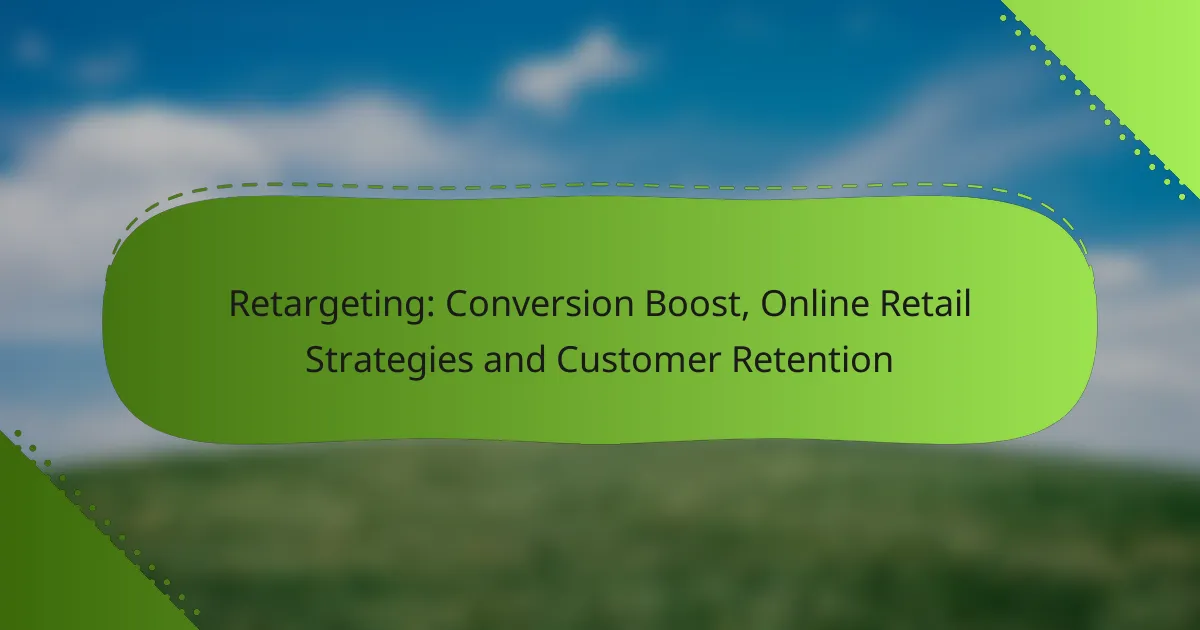Retargeting is a powerful online retail strategy that enhances conversions by reminding potential customers of products they previously viewed, encouraging them to finalize their purchases. By utilizing cookies to track user behavior, retailers can deliver tailored ads across various platforms, significantly increasing the chances of conversion and fostering customer retention.
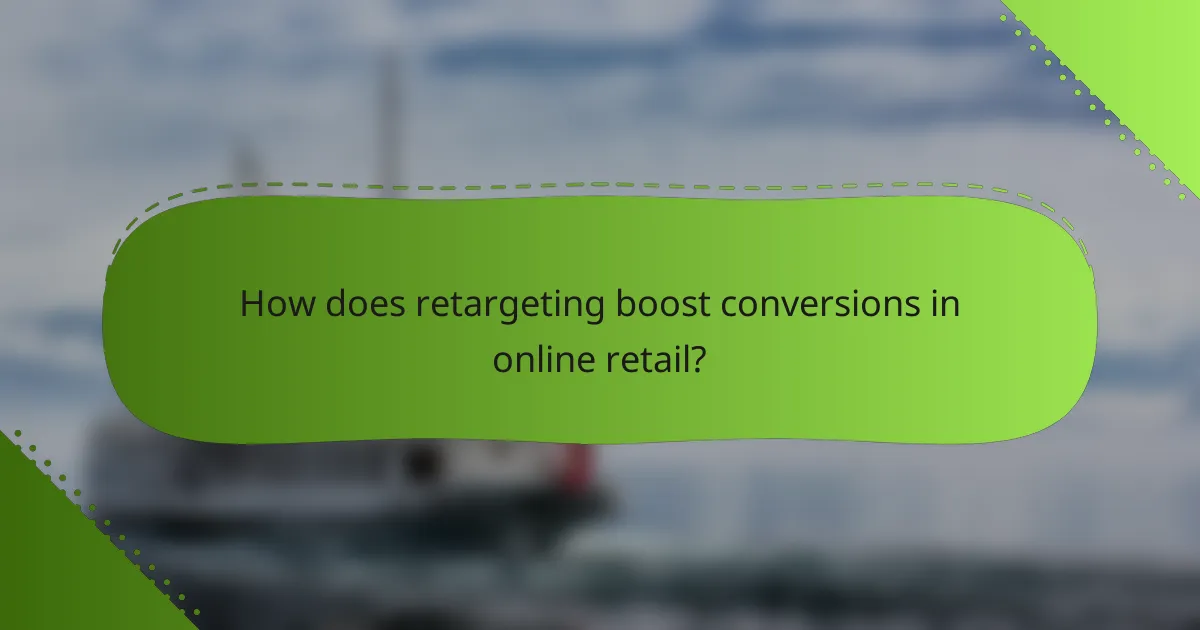
How does retargeting boost conversions in online retail?
Retargeting enhances conversions in online retail by reminding potential customers of products they previously viewed, encouraging them to complete their purchases. This strategy leverages cookies to track user behavior, allowing retailers to display targeted ads across various platforms, thus increasing the likelihood of conversion.
Increased brand recall
Retargeting significantly boosts brand recall by keeping a retailer’s products top-of-mind for consumers. When users see ads for items they have previously shown interest in, they are more likely to remember the brand and consider it when making a purchase decision.
For example, if a customer browses a pair of shoes on an online store but does not buy them, seeing those shoes in ads on social media or other websites can prompt them to return and complete the purchase. This repeated exposure reinforces brand recognition and familiarity.
Higher engagement rates
Retargeting campaigns typically yield higher engagement rates compared to standard advertising methods. Since the audience has already expressed interest in the products, they are more likely to interact with ads that feature those items.
Retailers can enhance engagement by personalizing ads based on user behavior, such as showing complementary products or offering discounts. This tailored approach can lead to increased click-through rates and ultimately drive more traffic back to the retailer’s site.
Improved ROI on ad spend
Retargeting can lead to improved return on investment (ROI) for advertising spend, as it targets users who are already familiar with the brand. This focused approach often results in higher conversion rates, making each advertising dollar more effective.
Retailers should monitor their retargeting campaigns closely, adjusting bids and budgets based on performance metrics. By analyzing which ads perform best, businesses can optimize their strategies to maximize ROI, potentially achieving returns that are significantly higher than traditional advertising methods.

What are effective retargeting strategies for online retailers?
Effective retargeting strategies for online retailers focus on re-engaging potential customers who have previously interacted with their products or website. By utilizing tailored ads and targeted messaging, retailers can significantly boost conversion rates and enhance customer retention.
Dynamic product ads
Dynamic product ads automatically showcase products that users have previously viewed or shown interest in. These ads pull data from your product catalog and display relevant items to potential customers across various platforms. For instance, if a shopper looked at a specific pair of shoes, they might see ads featuring those shoes on social media or other websites.
To implement dynamic product ads effectively, ensure your product feed is up-to-date and accurately reflects inventory. Consider using platforms like Facebook or Google Ads, which offer tools to create these personalized ads easily. Monitor performance metrics to optimize your campaigns and adjust your product selections based on user engagement.
Segmented audience targeting
Segmented audience targeting involves dividing your audience into specific groups based on their behavior, demographics, or purchase history. This allows retailers to tailor their messaging and offers to resonate more with each segment. For example, first-time visitors might receive a discount code, while returning customers could be targeted with loyalty rewards.
To effectively segment your audience, utilize analytics tools to gather data on user behavior. Create distinct segments based on criteria such as cart abandonment, browsing history, or previous purchases. This targeted approach can lead to higher engagement rates and improved conversion outcomes.
Cross-device retargeting
Cross-device retargeting ensures that your ads reach users across multiple devices, such as smartphones, tablets, and desktops. This strategy recognizes that consumers often switch devices during their shopping journey, and it aims to maintain consistent messaging throughout. For instance, a user might browse products on their phone and later receive ads on their laptop.
To implement cross-device retargeting, use tracking technologies that identify users across different devices. Platforms like Google Ads and Facebook provide options for cross-device campaigns. Ensure your ads are optimized for various screen sizes and formats to enhance user experience and drive conversions effectively.
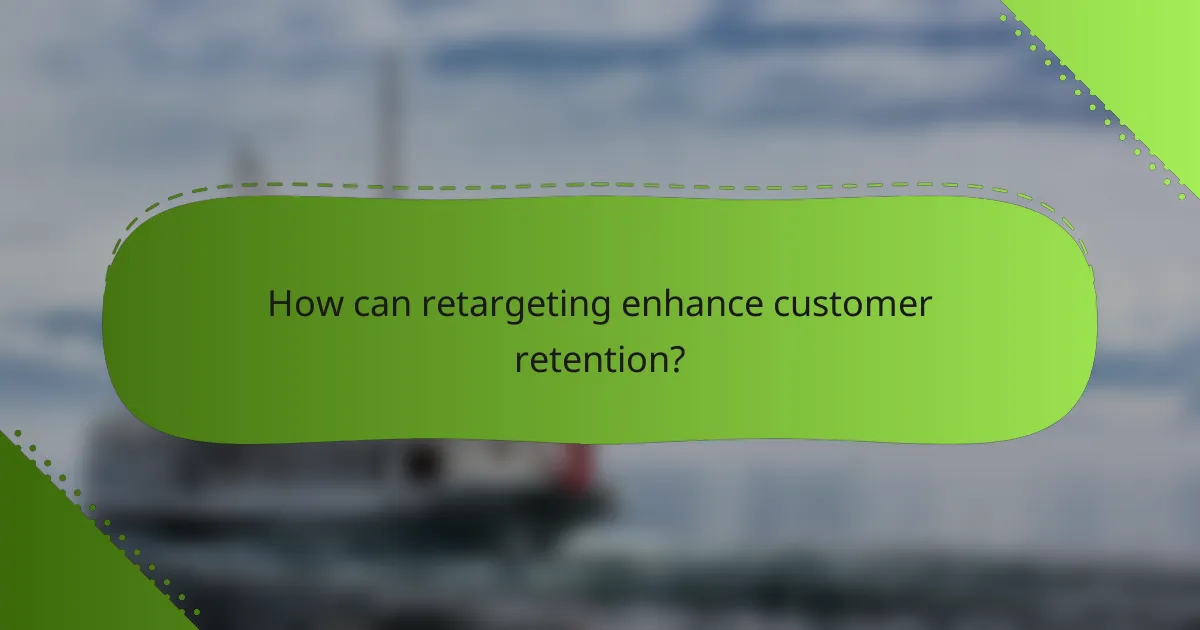
How can retargeting enhance customer retention?
Retargeting can significantly boost customer retention by reminding previous visitors of products they showed interest in, thereby encouraging them to return and complete their purchases. This strategy leverages personalized ads to create a sense of familiarity and relevance, which can lead to increased loyalty and repeat business.
Personalized marketing messages
Personalized marketing messages are crucial in retargeting efforts. By tailoring ads based on users’ past interactions, such as viewed products or abandoned carts, businesses can create a more engaging experience. For instance, a customer who browsed running shoes might see ads featuring those specific models, enhancing the likelihood of a return visit.
Utilizing data analytics tools can help identify customer preferences and behaviors, allowing for more effective message customization. This approach not only captures attention but also builds a connection, making customers feel valued and understood.
Incentives for repeat purchases
Offering incentives for repeat purchases can be a powerful motivator in retargeting campaigns. Discounts, loyalty points, or exclusive offers can entice customers to return and finalize their transactions. For example, a retailer might send a 10% discount code to users who left items in their cart, prompting them to complete the purchase.
It’s essential to balance the value of incentives with profitability. While discounts can drive sales, they should be strategically used to avoid eroding profit margins. Consider testing different types of incentives to determine what resonates best with your audience and leads to higher retention rates.
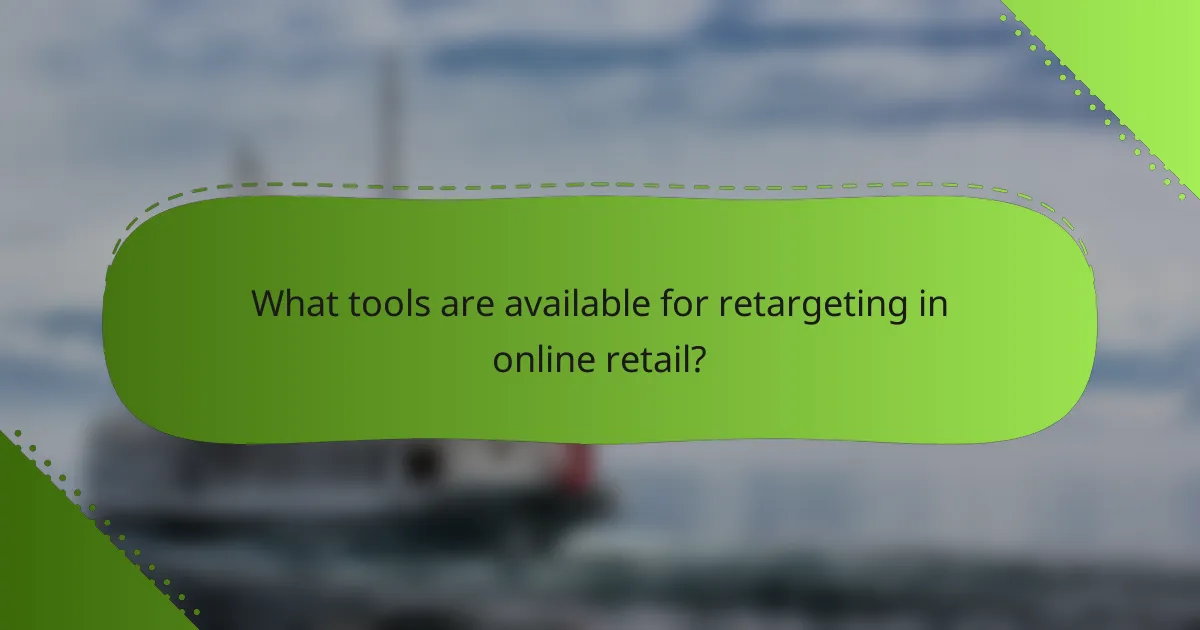
What tools are available for retargeting in online retail?
Several effective tools exist for retargeting in online retail, allowing businesses to reconnect with potential customers who have previously interacted with their website. These tools help increase conversion rates by displaying targeted ads to users across various platforms, reminding them of products they viewed or added to their cart.
Google Ads
Google Ads offers a robust retargeting solution through its Display Network, enabling retailers to show ads to users who have visited their site. By using remarketing lists, businesses can segment audiences based on their behavior, such as pages visited or actions taken, allowing for tailored messaging that resonates with specific interests.
To implement Google Ads retargeting, set up a remarketing tag on your website and create lists based on user interactions. Consider using dynamic ads that automatically showcase products users viewed, which can significantly enhance engagement and conversion rates.
Facebook Ads
Facebook Ads provides a powerful platform for retargeting through its Custom Audiences feature, allowing retailers to reach users who have engaged with their brand on Facebook or Instagram. This tool enables businesses to create highly targeted ads based on user behavior, such as website visits or interactions with previous ads.
To effectively use Facebook Ads for retargeting, install the Facebook Pixel on your site to track user actions. Create segmented audiences to deliver personalized ads, and experiment with different ad formats, like carousel ads, to showcase multiple products and drive higher engagement.
AdRoll
AdRoll specializes in retargeting across multiple platforms, including social media and email, making it a versatile choice for online retailers. It allows businesses to create comprehensive retargeting campaigns that follow users across the web, increasing brand visibility and encouraging return visits.
When using AdRoll, take advantage of its cross-channel capabilities to reach customers on various devices. Utilize its analytics tools to monitor campaign performance and adjust strategies based on user engagement and conversion data, ensuring that your retargeting efforts remain effective and relevant.
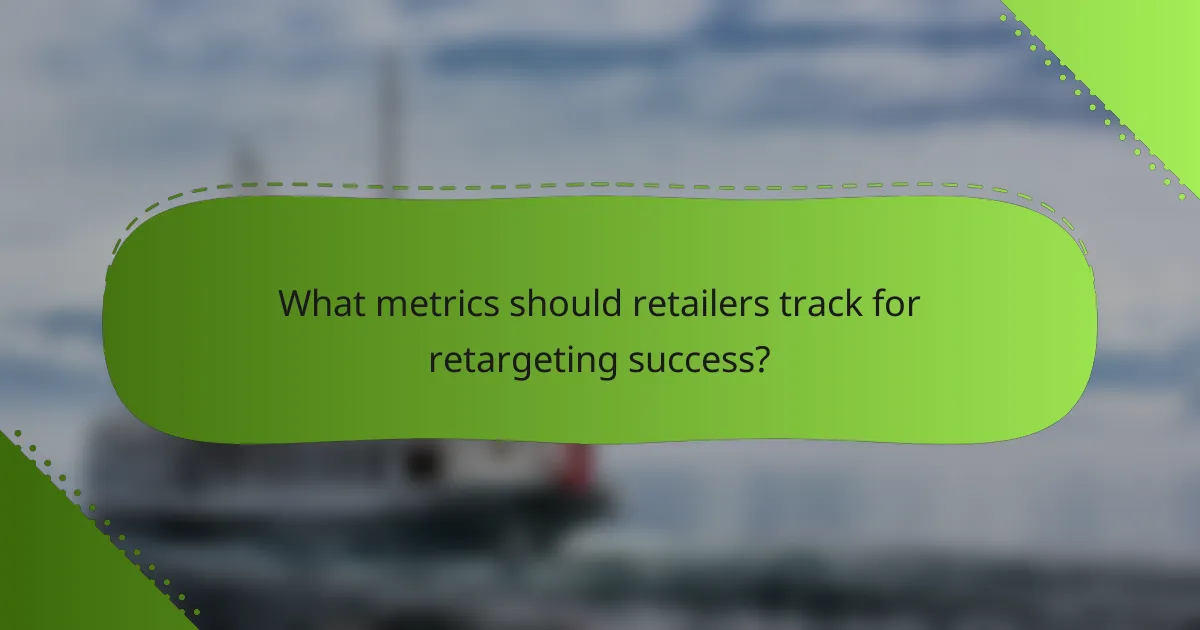
What metrics should retailers track for retargeting success?
Retailers should focus on key metrics such as conversion rate, click-through rate, and customer lifetime value to gauge the effectiveness of their retargeting efforts. These metrics provide insights into how well retargeting campaigns are performing and where improvements can be made.
Conversion rate
The conversion rate measures the percentage of users who complete a desired action after being retargeted. For online retailers, this often means making a purchase. A good conversion rate typically ranges from 1% to 5%, but this can vary based on the industry and the effectiveness of the retargeting strategy.
To improve conversion rates, retailers should ensure that their ads are relevant and personalized. Testing different ad creatives and offers can help identify what resonates best with the target audience.
Click-through rate
Click-through rate (CTR) indicates how many users clicked on a retargeting ad compared to how many times it was shown. A higher CTR suggests that the ad is engaging and relevant to the audience. Average CTRs for retargeting ads can range from 0.5% to 2%, depending on the platform and audience targeting.
To enhance CTR, retailers should focus on compelling visuals and clear calls to action. A/B testing different headlines and images can provide valuable insights into what drives clicks.
Customer lifetime value
Customer lifetime value (CLV) estimates the total revenue a retailer can expect from a customer over their entire relationship. Understanding CLV helps retailers determine how much they can afford to spend on retargeting efforts. A typical CLV can vary widely, often ranging from a few hundred to several thousand dollars, depending on the business model.
To maximize CLV, retailers should focus on customer retention strategies, such as loyalty programs and personalized marketing. By increasing the value of each customer, retailers can justify higher spending on retargeting campaigns.
